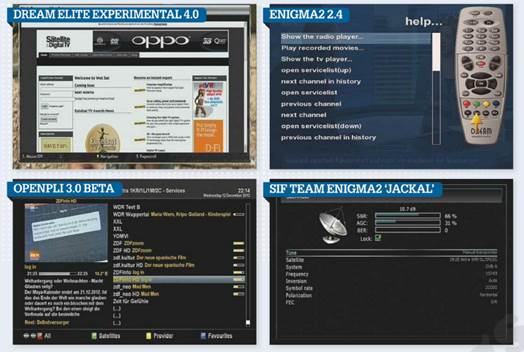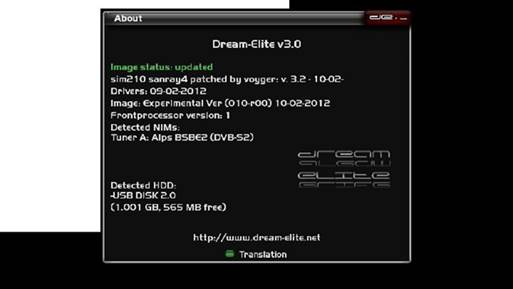We try four of the latest
freely-available firmware ‘images’ for Dreamboxes and other Linux-based
satellite receivers
Ehgma2 – the most common incarnation of the
Linux-based firmware originally developed for the Dreambox by its manufacturer
continues to form the basis of practically every Dreambox firmware ‘image’ that
is currently doing the rounds; indeed, its influence can be seen in all of the
firmwares in this group test. A wide range of non-Dreambox Linux receivers have
benefitted from Enigma2 too – we list the compatible receivers for each of
these four ‘images’.

Four
of the latest freely-available firmware ‘images’ for Dreamboxes
Dream Multimedia isn’t too happy about this
state of affairs, as it has in effect subsidized the software development costs
of its competitors! As far as Dream is concerned, the original idea behind
‘open-source’ firmware was that a worldwide community of Dreambox users and
third-party developers could collaborate to improve it.
Such modifications have included the
elimination of ‘bugs’, a change of user-interface ‘look’ or the addition of
radically-new features. Some of the latter, such as blind scan, have since been
incorporated into Dream Multimedia’s ‘official’ firmware releases. Others,
including the ability to support a second (USB) tuner or ability to emulate
various CAMs, haven’t.
Replacement firmwares help to keep
obsolescence at bay – the limiting factors are the imaginations of the
programming teams and the capabilities of the available hardware. Think of an
alternative firmware as a ‘personality change’ for your receiver – albeit a
moderate one, as its origins are usually evident in the basic structure of the
original firmware’s user interface.
So why is Enigma2 so important? Apart from
the fact that the source code was made available openly, thereby removing the
need to develop a new image ‘from the ground up’, its power and overall
stability are something to aspire to. Another of Enigma2’s draws is that you
can choose from a wide range of ‘plugins’ – free third-party ‘apps’.
The only disadvantage of Enigma2 (and its
variants) is that it’s not quite as intuitive to use as the average firmware
built into the non-Linux set-top box. Over time, though, the user will quickly
acquire familiarity with these idiosyncrasies and indeed see them as the
advantages they can be!
Install tips
·
A Dreambox’s second-stage ‘bootloader’ can be
used to quickly install new firmware. From its webpage, select a firmware .nfi
‘image’ file that you’ve previously downloaded to your PC.
·
Choose an image specific to your receiver. Even
with the correct file, you might experience an error message – you might need a
new bootloader. Some plugins are also hardware-specific
·
You can only have one firmware installed at a
time. Some ‘multiboot’ utilities (notably ‘Barry Allen’) will allow you store
several firmwares on an external storage device
Dream Elite EXP 4.0
A well thought-out firmware with a
web-browser built in as standard – in addition to more useful features
This image is based around version 2 of the
‘Open Embedded’ software environment (‘OE2’). Its software ‘sources’ may be
experimental, but the image is claimed to be stable, its basis in the official
Dreambox image is obvious; for a start, the useful web interface (For
controlling the receiver and network-streaming channels) is identical.
Installation involves the usual Dream ‘wizard’. Although ‘restore settings’ is
present, we had to reset the ‘mount-point’ of the hard drive fitted to
DM800HDse before use.

Dream
Elite EXP 3.0
The most noticeable change has been the
addition of a web browser to the usual ‘main menu’ entries. Indeed, Dream Elite
is the only image to include this as standard. It’s difficult to use without a
wireless keyboard and mouse (both of which are supported here), and was rather
slow. Without these a handset-driven virtual keyboard is used to enter URLs,
which can thankfully be bookmarked. Another major difference is the ‘device
manager’, which lives in the setup/system menu. In addition to storage devices,
this will look after USB DVB-T tuners. Only a limited number are supported; the
PCTV 290w we tried was alas not among them.
As far as onboard tuners are concerned,
though, it’s business as usual. Configure the tuner, and then search for
channels. We’re pleased to note that blind-scan is available. Channels are
arranged in the Enigma 2 ‘bouquet’ format, and can be sorted by satellites,
provider or ‘favorites’. The ‘current transponder’ option is also available,
and owners of single-tuner boxes will know what channels can be simultaneously
viewed and recorded.

Dream-Elite-4.0
has been updated image Dream-Elite-3.0 To become 4.0
The ‘stock Engma2’ EPG is compatible with
now/next and 7-day schedules, and can set the timer. You won’t find CrossEPG
among the numerous plugins and skins of the conventional ‘plugins’ list, but it
can be installed. Pressing the handset’s blue button once brings up a menu that
deals with ‘soft’ (emulated) CAMs. If you press it again you’ll access the
Dream Enigma ‘Addons Manager’ and you’ll find CrossEPG in the ‘DEPlugins’
option of the ‘download addons’ menu. These plugins are specifically designed
to work with OE2.0.
Others include file search,
weather-forecasting, a sport portal and video streaming. Recording and TV use
posed no problems, although you cannot use the TV recordings manager to
directly access multimedia files. Instead, you have to rely on the separate
media player and picture player (via the ‘plugin browser’) to cover everything.
Verdict
Although Dream Elite is feature-packed,
it’s a pity that our DVB-T2-compliant USB stick wouldn’t work (both HD
satellite and terrestrial in a single box would be appreciated).
|
Dream Elite
EXP 4.0
§ Version
tested: Experimental 4.0 (001-r02) 02-12-2-12
§ Restore
of previous settings: Yes
§ Blind
scan: Yes
§ Network
browsing: Yes
§ Receivers
supported: Dreambox DM500HD, DM800HD, DM800HDse, DM7020HD, DM8000HD
§ Web
interface: Yes (Dreambox Webcontrol)
§ Video
formats: DivX, XviD, MOV, MPEG-1, MPEG-2, MKV (to 1080p)
§ Audio
formats: MP3, MP2, WAV, WMA, M4A, FLAC
§ Image
formats: GIF, JPG, BMP, PNG
§ Cue/review
with all video formats: No
§ EPG
days: DVB now/next and 7-day, CrossEPG
§ PVR:
Via USB, network or HDD
§ Channel
change: 1 sec
§ Reboot
time: 1 min 26 sec
Ratings
Plus
§ Stable
and useful shortcuts
§ Decent
spread of features
Minus
§ Dreambox-only
multimedia playback arrangements could be improved
§ Ease
to use: 8/10
§ Navigation:
8/10
§ Searching:
9/10
§ Performance:
9/10
§ Value:
7/10
§ Overall:
8.5/10
|